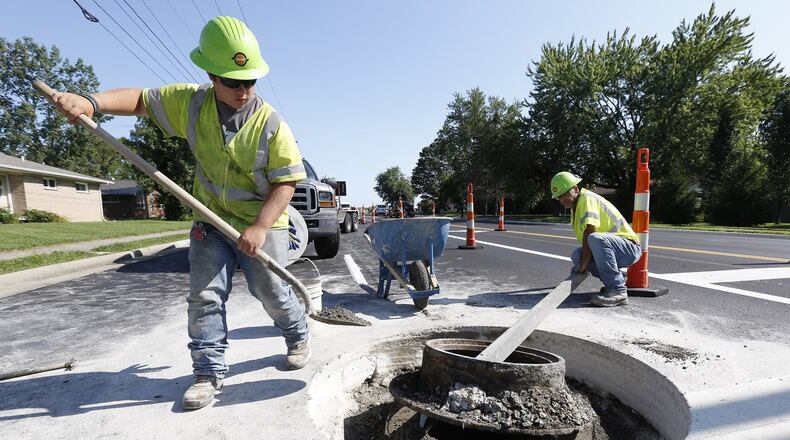An annual Policy Matters Ohio report tracks some of the more frustrating numbers, reporting that the best benefits of a 121-month expansion are “proving elusive” for Ohio workers.
»BIZ BEAT: Robotexts a growing concern for fraudulent activity
From the report: Median wages in the state have edged up since 2011, while remaining behind national levels.
In terms of employment levels, Ohio has 28,000 fewer jobs than it did in the early 2000s.
“Wages have kind of edged upward,” said Amy Hanauer, report author and executive director of Policy Matters Ohio, a liberal-leaning think tank. “Unemployment is nice and low.”
But as Hanauer and her colleagues see it, Ohio isn’t where it should be after so long a recovery.
“It really doesn’t feel like that big of an expansion,” she said.
Some of these concerns cut across ideological lines. The conservative-leaning Buckeye Institute’s Andrew Kidd, an economist, has called out what he called “conflicting signals” in last month’s state employment data.
“Despite an increase of 2,500 private sector jobs in July, Ohio’s private sector employment is still down 13,900 jobs since January 2019, Kidd said in a statement.
»RELATED: Clothing store Forever 21 weighs bankruptcy filing
Kidd said he sees several factors at work: It has been a long expansion, he said, but also a slow one.
“Generally speaking, we lag,” Kidd said. “I think it gets back to our roots. Our state was built on manufacturing.”
He doesn’t see the U.S. ever shifting completely away from manufacturing, but nationally, the economy has become more service-oriented. Americans have had to adjust to that.
“You see pockets of the state like this,” Kidd said. “Columbus is one area — and Dayton is as well — that have done well in terms of rebounding. Job growth is continuing there, we’re kind of getting back to where we were pre-recession.”
He added: “But we’re seeing other areas of the state, rural areas especially, that have struggled to get back to where they were, that don’t really have the same workforce base.”
Marick Masters, director of Labor@Wayne at Wayne State University in Detroit, sees some signs of restlessness, pointing to teachers’ strikes in West Virginia and elsewhere, the largest hotel workers strike in U.S. history that ended last year and a possible strike by non-faculty university employees in Oregon.
»RELATED: Dorothy Lane Market to launch Love Cakes storefront
”I think are signs in certain areas of growing militancy among workers, but it remains to be seen whether we’re at a tipping point in the sense that this could produce significant gains in union membership and bargaining representation,” Masters said.
In its report, Policy Matters Ohio says Ohio has never had such a large share of men who are not working and not looking for work.
Hanauer sees the opioid epidemic as one problem keeping some men out of the workforce. She argues that higher wages would pull more people into job-search arena.
The typical union member earns over $10,000 more a year than the typical non-union worker, according to Policy Matters. But union jobs are disappearing. Hanauer noted that General Motors closed its Lordstown plant this year, where GM workers assembled the Chevrolet Cruze.
According to a Bloomberg report, GM today employs fewer union-represented American workers than its domestic rivals for the first time since the UAW started organizing domestic automakers some 80 years ago.
Ohio’s jobless rate was 4.5 percent for all of 2018 and an even lower four percent in June and July this year. Even Policy Matters says those numbers are “almost as good as it gets.”
“We’re still seeing wages going up; you still see people finding jobs when they need to find jobs,” Kidd said.
FIVE FAST READS
•The steps Connor Betts took to commit Ohio's largest mass shooting
• Kettering book store to go out of business
• Local Victoria’s Secret, Bath & Body call center hiring 2K seasonal workers
•PHOTOS: More than 2K UD freshmen move in
• Three more local stores set to close after national retailer liquidates
By the numbers
Jobs
5,621,400 jobs: the number of Ohio jobs before the early 2000s recession.
5,593,000 jobs: Ohio's job count as of July.
235,000: The number of workers unemployed in Ohio in July, up 2,000 from 233,000 in June.
4.7: Montgomery County's July 2019 unemployment rate.
4: Ohio unemployment rate in July.
3.7: U.S. jobless rate in July.
Sources: Ohio Department of Job and Family Services, U.S. Bureau of Labor Statistics
About the Author

